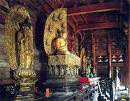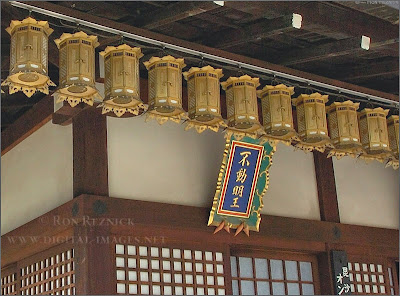:::::::::::::::::::::::::::::::::::::::::::::::::::::::::::::::::::::::::::::::::::::::::::::::::::::
Daruma Pilgrims Gallery
:::::::::::::::::::::::::::::::::::::::::::::::::::::::::::::::::::::::::::::::::::::::::::::::::::::
Tooji, Tō-ji 東寺 Toji, To-Ji
Kyoo Oo Gokokuji 教王護国寺 Kyoo-Gokoku-ji
1 Kujo-cho, Minami-ku, Kyoto-shi, Kyoto
京都府京都市南区九条町1

source : www.kyotok.net
Tō-ji (東寺) is a Buddhist temple of the Shingon sect in Kyoto, Japan.
Its name means East Temple, and it once had a partner, Sai-ji (西寺 West Temple). They stood alongside the Rashomon, the gate to the Heian capital. It is formally known as Kyō-ō-gokoku-ji (教王護国寺, Kyō-ō-gokoku-ji) which indicates that it previously functioned as a temple providing protection for the nation. Tō-ji is located in Minami-ku near the intersection of Ōmiya Street and Kujō Street, southwest of Kyoto Station.
Although often associated with the famous priest Kōbō Daishi (Kūkai), Tō-ji was established in 796 A.D., two years after the capital moved to Heian-kyō. Kūkai was put in charge of Tō-ji in 823 A.D. by order of Emperor Saga. Its principal image is of Yakushi Nyorai, the healing Buddha.
Ancient building at Tō-ji
The pagoda of Tō-ji stands 57 m high,
and is the tallest wooden tower in Japan.
It dates from the Edo period, when it was rebuilt by order of the third Tokugawa Shogun, Iemitsu. The pagoda has been, and continues to be, a symbol of Kyoto. Entrance into the pagoda itself is permitted only a few days a year.
The buildings at Tō-ji house a variety of ancient Buddhist sculpture.
The Golden Hall, Kondo has statues of the Buddha of Healing, Yakushi Nyorai and two of his attendants, Nikko and Gakko Bosatsu. In the Lecture Hall, there is a group of 21 Buddhist statues, arranged in the form of a three-dimensional Mandala of Esoteric Buddhism, as prescribed in the main sutra of Shingon Buddhism.
The grounds feature a garden and pond, in which turtles and koi swim. The grounds also house an academically rigorous private school, Rakunan, from which many students are sent to elite universities.
Recognizing the historical and spiritual significance of Tō-ji, UNESCO designated it, along with several other treasures in Kyoto Prefecture, as part of the "Historic Monuments of Ancient Kyoto" World Heritage Site.
On the 21st of each month, a famous flea market is held on the grounds of Tō-ji . This market is popularly called Kōbō-san, in honor of Kōbō Daishi, who died on March 21st. The flea market feautures a variety of antiques, art, clothes, pottery, some food, and typical second-hand flea market goods. By far the largest market is held on December 21st, as it is the last of the year.
A similar market is held on the 25th of every month at Kitano Tenmangu, also called Tenjin. A Kyoto proverb proclaims, "Fair weather at Tō-ji market means rainy weather at Tenjin market," calling to mind Kyoto's fickle weather.
© More in the WIKIPEDIA !


真言宗東寺派 : 教王護国寺
東寺 Japanese Reference
:::::::::::::::::::::::::::::::::::::::::::::::::::::::::::::::::::::::::::::::::::::::::::::::::::::::

- quote
御影堂 Miei-do (Founder's Hall) (National Treasure)
This hall was the residence of Kukai, the founder of Shingon Buddhism. It is also called Daishido, because Kukai's posthumous name is Kobo Daishi. Another name for it is Fudo-do, because every day, Kukai used to pray to the Fudo-Myo-o (secret Buddha, a national treasure).
This hall was burnt down in 1379, and was rebuilt in 1380. In 1390, a statue of Kukai was added.
- source and more : www.cis.doshisha.ac.jp/kkitao

- source and more photos : www.digital-images.net/Gallery
:::::::::::::::::::::::::::::::::::::::::::::::::::::::::::::::::::::::::::::::::::::::::::::::::::::
I visited this temple many times, it is very close to Kyoto Station.
To sit under the big red umbrella in the park and look at the pagoda ... And to meet the many fascinating Buddha statues in the three-dimensional mandala arrangement ... moments of silence and thundering awe !
Daruma Museum : Introducing
Kobo Daishi, Kukai 弘法大師 空海

This temple is Number 9 on the
Pilgrimage to 18 Shingon Temples

- source : facebook
Part of the rittai mandala with Fudo Myo-O 不動明王
立体曼荼羅
:::::::::::::::::::::::::::::::::::::::::::::::::::::::::::::::::::::::::::::::::::::::::::::::::::::::

source : kissyarita.blog.fc2.com
Fudo Myo-O
. Fudō Myō-ō, Fudoo Myoo-Oo 不動明王 Fudo Myo-O
Acala Vidyârâja - Vidyaraja .
:::::::::::::::::::::::::::::::::::::::::::::::::::::::::::::::::::::::::::::::::::::::::::::::::::::::
. . . . . H A I K U . . . . .

© PHOTO: kyotomachiyagallery
塔ばかり見へて東寺は夏木立
too bakari miete tooji wa natsu kodachi
Toh Temple--
just its pagoda shows
over the summer trees
by Issa, 1792
Tr. David Lanoue
Haiga by Nakamura Sakuo
:::::::::::::::::::::::::::::::::::::::::::::::::::::::::::::::::::::::::::::::::::::::::::::::::::::

前池の 亀も見上げる 夏の塔
turtles in the pond
are looking up with me -
pagoda in summer

- Shared by Naotaka Uematsu -
Haiku Culture Magazine, 2013
:::::::::::::::::::::::::::::::::::::::::::::::::::::::::::::::::::::::::::::::::::::::::::::::::::::
To-Ji Nana Fushigi 東寺七不思議 Seven Wonders of Temple To-Ji

Neko no magari 猫の曲り "The Cat Corner"
The corner of the South-East 築地塀(ついじべい) Tsuiji fence of temple To-Ji is called "Neko no Magari" and is feared as a place where ghosts and spooks reside. If people pass around this corner, they will experience misfortune. So even today a bridal procession will never pass along this corner.
This explanation goes back to the Heian period and the belief in the animal deities of the Four Directions. A statue of each one had been erected at the appropriate corner of the temple.
The statue of Byakko 白虎, the White Tiger in the West, had looked very much like a cat and people called it neko no magari-kado 猫の曲がり角 , the corner where the cat turns. But the statue had been removed at the beginning of the Meiji period.
Careful, maybe the protector deity of the West had been mis-placed in the South-East for some unknown reason and thus caused trouble ?!
There is another simpler explanation:
Since this corner is located in daily sunshine, many alley cats have come to live here.
.......................................................................
hyootanike 瓢箪池 the Hyotan-ike "gourd pond".
During a strong earthquake around 1854-60 the 五重塔 five-storied pagoda begun to lean to the side. To counterbalance the effect, the pond Hyotanike was dug out by the people.
The pond is also called Hasuike 蓮池 Lotus Pond.
.......................................................................
akezu no mon 不開門(あけずのもん)the gate that is not opened
anamon 穴門(あなもん) gate with a hole
hoozoo宝蔵(ほうぞう) Hozo treasure store house
rengemon 蓮華門(れんげもん) Lotus gate
tenkooseki 天降石(てんこうせき)a stone fallen from heaven
.......................................................................
- reference source : cyber-world.jp.net/tougi-nanafushigi -
. Nanafushigi, nana fushigi 七不思議 "The Seven Wonders" .
There are many places which boast "seven wonders" in Japan.
:::::::::::::::::::::::::::::::::::::::::::::::::::::::::::::::::::::::::::::::::::::::::::::::::::::
Daruma Pilgrims in Japan
[ . BACK to WORLDKIGO TOP . ]
Too-Ji Toh-Ji, Touji Tou-Ji - #tojitemple #tooji -
:::::::::::::::::::::::::::::::::::::::::::::::::::::::::::::::::::::::::::::::::::::::::::::::::::::






6 comments:
danke, Gabi
dieses Issa-haiku ruft Erinnerungen wach ..
es war ein heißer Tag im Mai, als wir dieses Tempel besuchten
Gruss aus Deutschland !
Dear Gabi,
Whenever there is any reference to Buddha, it delights me since my native place Orissa has contributed a lot for the spread of peace and love across the world after Emperor Ashoka transformed himself to an icon of peace and love.
Is that not wonderful? Who can match Issa, still my lines in his honour are below:
Peepal at Bodhagaya —
lighted up by the halo
of meditating Buddha
Best regards and love
Kumarendra Mallick, Hyderabad, India
.
early morn
temple bells in the town
god's awakened
Sunil Uniyal, India
Masaoka Shiki visiting
幽霊ノ如キ東寺ヤ朧月
茶つみ歌東寺の塔は霞みけり
Kyoto, Tōji
"Hyakugōmonjo" documents spanning from the Heian to early Edo period
have been approved as a World's Memory Property by the UNESCO
ユネスコの記憶遺産(世界記憶遺産)に、東寺百合文書が認定された。
On Tōji "Hyakugōmonjo": 東寺百合文書 とうじひゃくごうもんじょ
http://atogaki.hatenablog.com/entry/2015/10/10/193733
The Seven Wonders of Toji
不思議
http://www.eonet.ne.jp/~kyoto-fushigi/sub29.html
.
One of the Seven Wonders of the temple Toji in Kyoto 東寺の七不思議
4 - hyootanike 瓢箪池 the Hyotan-ike "gourd pond".
During a strong earthquake around 1854-60 the 五重塔 five-storied pagoda begun to lean to the side. To counterbalance the effect, the pond Hyotanike was dug out by the people.
The pond is also called Hasuike 蓮池 Lotus Pond.
.
My Legends about earthquakes
http://heianperiodjapan.blogspot.jp/2016/04/earthquake-jishin-legends.html
.
Post a Comment